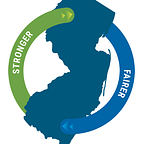Kicking off a new approach to delivering workforce development services
By Hugh Bailey — Assistant Commissioner, Workforce Development New Jersey Department of Labor and Workforce Development
This past Wednesday, leaders representing every division of the New Jersey Department of Labor and Workforce Development met together with technology providers, service designers and innovation experts from the state’s Office of Innovation and workforce development professionals from the Heldrich Center for Workforce Development at Rutgers University.
We kicked off a planning process focused on using data-driven and human-centered approaches to changing how we deliver workforce development services for the state and its residents. The goal of the project? To improve workforce development tools, methods and services, enhancing services for those seeking work as well as the companies who hire them, and providing state of-the-art digital tools, coaching, training programs, and a host of other work-related services.
While the outcomes of our work are important, we’re also focused on developing these services in a new and better way — one that puts the people we serve at the center of the process — tapping your intelligence and experience to develop the services you want and need. Hence, we are publishing this blog to share our process with you openly and transparently, seek your input and getting your advice and feedback.
We kicked off the effort by seeking to define specific and actionable problems we are trying to solve.
Whether in government or the private sector, typically most of us jump straight to solutions. But taking the time to define the problems we are solving is crucial. If we champion a solution — based on a perceived but inaccurate understanding of what the problem actually is — we end up solving the wrong problem and reduce the likelihood of developing solutions that actually work.
Thus, we began by trying to articulate some specific problems, such as:
● Many job and career seekers are not aware of the existence of workforce development services because
● Whether online or in person, we do not make it clear enough to know where to begin, or, in other words, which services to access depending on your circumstances
● Although most people carry smartphones, we do not provide enough online services to people taking advantage of new technology
We identified a long list and are now setting to the task in the coming weeks of using data and talking to customers to understand these problems and their root causes so we can identify useful solutions.
As the next step in our process, we will expand, refine and share our problem statements. Simultaneously, we will document the services we currently offer, creating an “asset map” of state workforce resources to identify what we do well and where there are gaps.
We are interested in hearing from you as well. What do you see as being the primary impediments to delivering effective workforce development services to employees, potential employees and employers? Please share with us below.
